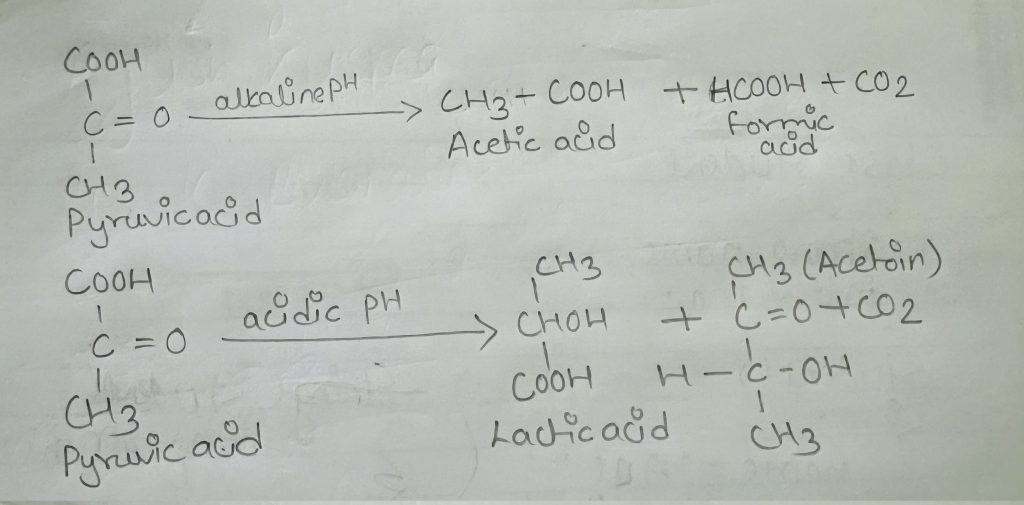Introduction:
The biochemical (physiological) reactions of the miens organisms are very much important in species identification. Differentiation of the principal groups of enterobacteriaceae caccomplished on the basis of their biochemical properties for this IMVIC series of tests which stands for Indole, Methyl Red, Voges-Proskauer and Citrate Utilisation.
Indole test:
The basic principle of Indole test is to determine the ability of an organism to split the amino acid “tryptophan” into Indole. The test is one of the important biochemical tests to differentiate between genera and even between species of bacteria particularly of the enterobacteriaceae group.
Tryptophan is an amino acid that can be oxidised by certain bacteria to form three majors. Indolic Metabolites Indole skatole indole acetate various intracellular enzymes involved are collectively called “tryptophanase” that mediate the production of Indole. The degradation of Tryptophan releases Indole pyruvic acid, ammonia and energy. The pyruvic acid further metabolises either by way of the glycolytic cycle or can enter Krebs cycle to release CO₂, H₂O & a large field of energy, NH3 can be used to synthesise new acids by utilising energy present for anabolic reaction.

The indole split from Tryptophan Molecule, can be detected by a reagent which involves a chemical combination producing a distinct colour. The presence of Indole formation is used for bacterial identification. Indole if present combines with aldehyde present in either Kovac’s reagent to give red colour in alcohol layer. The colour reaction is based on the presence of pyrrole structure present in Indole. The CH2 group of pyrrole permits condensation with the aldehyde in two procedures.

The alcoholic layer extracts and concentrates the red colour complex. The characteristics of some of the bacteria towards Indole test are E. coli (usually +) Klebsiella Enterobactor (usually-)
Bacillus alvei(+), other Bacillus sps (-)
Proteus mirabilis(-), other Proteus sps (+)

Materials Required
i) Inoculating loop
ii) Bunsen
iii) Media: tryptophan broth or tryptone broth
iv) Nutrient broth culture of E. coli and Enterobector aerogenes
v) Kovac’s reagent or Enrlich’s reagent.
Procedure:
i) A sterilised test tube containing approximately 4ml of tryptophan broth was taken.
ii) The test tube was inoculated aseptically by taking growth from an 18-24 hours. Pure culture with the help of sterilised inoculating loops.
iii) The tube was inoculated 35°C for 24-28 hours.
iv) 5 drops of kovacs reagent was added directly to the above or 48 hours one incubated broth tube.
v) The tube was shaken gently.
vi) The tube was allowed to stand to permit the reagent to come to top.
Observation
| Media Used | Reagent Used | Colour observed | Result | Inference |
| SIM | Kovac’s | Cherry redring | Indole | Indole positive |
| Used | reagent | On surface ofMedia | Positive | Bacteria observed |
Result :
The giver sample showed a positive Indole Test.
Discussion:
Like many biochemical tests on bacteria, results of an Indole test are indicated by a change in colour of a reaction with an added reagent. The given sample showed an indole positive test by performing a red ring at the surface of the medium.
Conclusion:
Hence, the Indole test of organisms was performed.
Precaution:
i) Cultures to be treated must be incubated aerobically.
ii) Experiment should be carried out in asceptic condition.
References:
Manandhar S;Sharma s;(2013), “Practical approach to microbiology” Revised edition, National book centre, Page 70-71.
Citrate Utilisation Test:
The basic principle of the testis detect the ability of an organism which can utilise citrate, as a sole source of carbon for their metabolism with resulting alkalimetry.
The media used for this test is simmon’s Citrate agar in which sodium citrate is the sole carbon source and ammonium ion is the sole nitrogen source. Bromothymol Blue (BTB) is included as a PH indicator source. Initially, PH of Medium is neutral (Ph = 6.9) where the Indicator is green in colour. Citric acid typically is produced by the combination of acetyl C.A and oxaloacetic acid at the entry to Kreb’s cycle. However some organisms are capable of using citrate as a carbon source if no. fermentable Carbohydrate is present. This requires citrate permease the enzyme responsible for transporting citrate into the cell. Once inside a cell, citrate can be broken down as;

Once inside a cell, citrate is hydraged by citrate into Oxaloacetic acid and acetic acid. The Oxaloacetic acid further hydrolysed into Pyruvic acid and CO₂. This excess CO₂ reacts with Na+ in the medium to produce alkaline compound sodium carbonate. This makes the medium alkaline BTB PH indicator Prussian blue.
Since this is an aerobic process, agar slants are used to increase the surface area exposed to air. The fate of pyruvic acid depends on cellular PH as;

Material Required:
i) Bacterial culture
ii) Semmon’s Citrate Agar Slant
iii) Burner
iv) Inoculating loop.

Procedure:
i) The Simmons Citrate agar slant was labelled with the name of the given organism.
ii) The organisms were inoculated on the surface of the medium in a zigzag way.
iii) The test tube was incubated at 37°C for about 48 hours.
iv) Observe the change in colour of the medium.
Observation:
| Media Used | Initial Colour | Colour Charged | Result | Inference |
| Simmon’s Citrate | Green Colour | Prussian | Citrate | Citrate +ve |
| agar Slant | on slant | Blue | Positive | Bacteria Obs |
Result:
The giver sample was positive for the citrate test.
Discussion:
The citrate test detects the ability of an organism to use citrate as the sole source of carbon and energy. This test is helpful in differentiating Enterobacteriaceae. The blue colour developed on the slant which indicates the organism to be citrate positive. The citrate test of the organism was performed.
Precautions:
i) Experiments should be carried out in aseptic conditions.
ii) A light inoculum should be used.
References:
Manandhar S;Sharma s; (2013) “Practical approach to Microbiology” Revised edition, National centre Page No. 74- 75.
